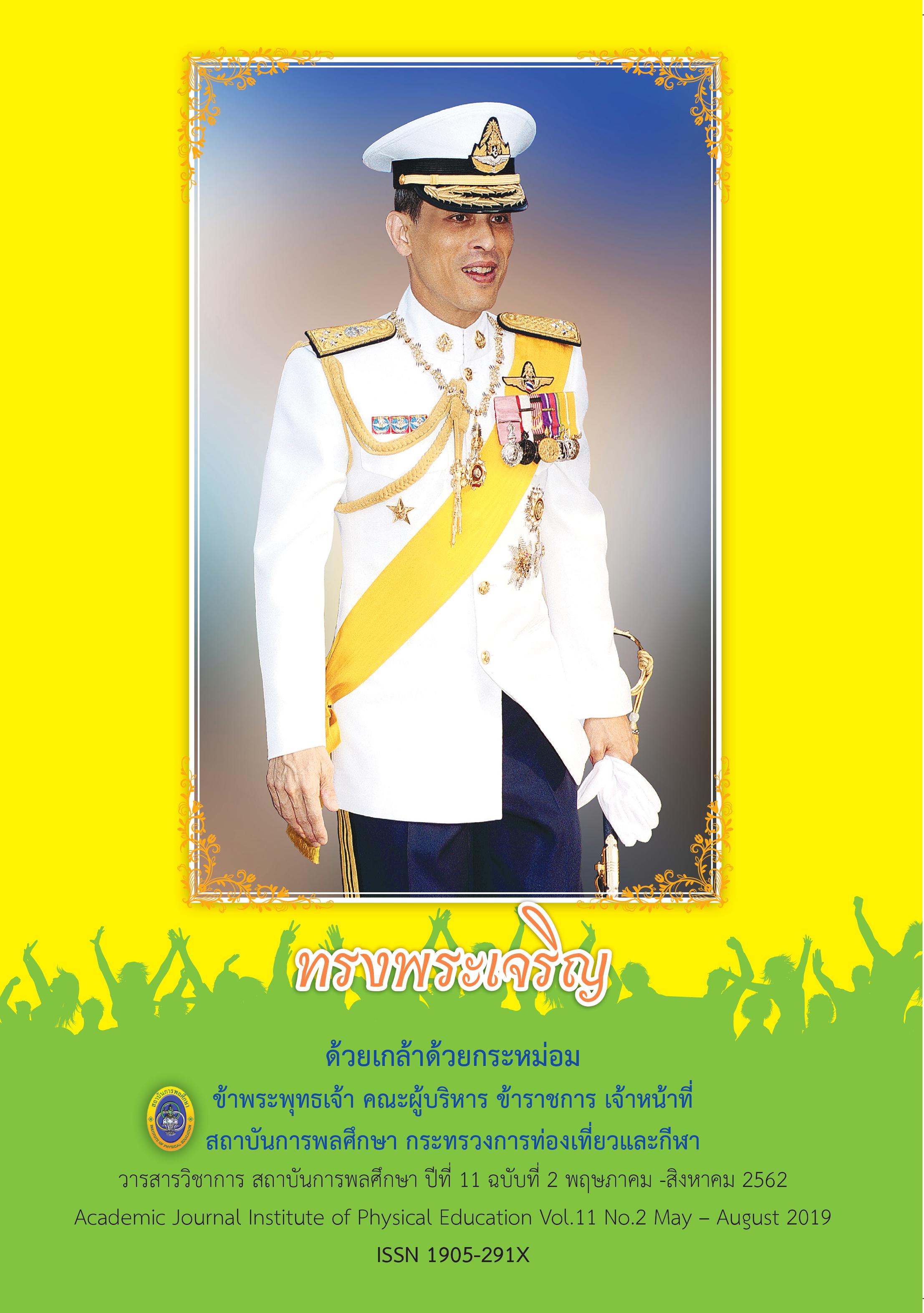DEVELOPMENT OF PHYSICAL EDUCATION LEARNING MODEL BASED ON THE CONCEPT OF OLYMPISM TO ENHANCE THE PEACEFUL COEXISTENCE OF SECONDARY SCHOOL STUDENTS
Main Article Content
Abstract
The purposes of this research were to develop and evaluate the effectiveness of physical education learning model based on the concept of olympism to enhance the peaceful coexistence of secondary school students. The subjects of this study were 32 students in Mathayom Suksa 1, purposive selected divided into 16 experimental groups and 16 controlled groups. The research process was developed and qualitatively inspected by experts with an aggregate IOC of 1.00 for 8 weeks of experimentation. Data were collected 3 times. The research instruments consisted of (1) Physical education knowledge test with a content validity index at .80, (2) Physical fitness achievement test had an aggregate IOC of 1.00, (3) Self-assessment to promote the values of olympism in friendship, and (4) Selfassessment to promote the values of olympism in respect, with a content validity index at .90 and .83 sequences. Using basic statistics, repeated measurements for comparing and t-test at the statistical significance difference at the 0.05
The research results were as follows: 1) Physical education learning model based on the concept of olympism to enhance the peaceful coexistence of secondary school students consisted of the following major parts: (1) the basic principles, theories of physical education model based on the concept of olympism (2) the model objectives (3) the learning contents (4) the instruction process, and (5) the learning assessment, the eight plans of which conprised 1) short sprint, 2) relay, 3) javelin, 4) throwing and 5) fitness, 6) high jump, 7) long jump, 8) Mini youth ancient olympic and modern olympic games which was found effective to promote the peaceful coexistence and the three core values of Olympism: (1) Excellence, (2) Friendship, (3) Respect to other 2) Significant differences of knowledge scores and behavior in peaceful coexistence were found in the experiment group and the control group at the level of .05.
Article Details
The published article is a copyright of the Academic Journal of Thailand National Sports University. The passage appeared in each article in this academic journal is a perspective of each author which is not related to the journal. Each author is required to be responsible for all components of his/her own article. If there are any mistakes, each author must be responsible for those mistakes on his/her own.
References
Binder, D. L. (2000). Be a champion in life: International teacher’s resource book. Athens: Foundation of Olympic and Sport Education.
Binder, D. L. (2010). Teaching Olympism in schools: OlympicEducation as a focus on values education. Bellaterra: Centre d’Estudis Olímpics (UAB).
Croll, P., Attwood, G., Fuller, C., & Last, K. (2008). The structure and implications of Children’s attitudes to school. British Journal of Educational Studies.
Gessman, R. (1992). Olympische Erziehung in der Schule unter besonderer Berueksichtigungdes Fair-play Gedankens [Olympic education and its school application. Olympic education in schools within the special context of the fair play idea]. Paper presented at the Proceedings of the First National Teacher Professional Workshop of the National Olympic Committee of Germany, Olympia, Greece, September 7-15.
Hastie, P.A. (2006). Teaching elementary physical education: strategies for the classroom teacher. U.S.A.: Pearson Benjamin Cumming is a trademark of Pearson Education.
Joyce, B. R., and Weil, Marsha. (1996). Model of Teaching. 4rd ed. Englewood cliffs, New Jersey: Prentice-Hall Inc.
International Olympic Committee. (2013). Olympic Charter. Did We Do S.a.r.l., Lausanne, Switzerland.
Kohlberg, L. (1976). Moral stage and moralization : The cognitive development and behavior: Theory research and social issues. New York: Holt, Reinhart and Winston.
Kultida Maopech. (2010). The development of a physical education instructional model based on theory of multiple intelligences to improve physical education learning achievement of elementary school students. Doctor of Philosophy Degree in Physical Education, Chulalongkorn University. [in thai]
Ministry of Education. (2008). The basic education core curriculum B.E. 2551 (A.D.2008). Bangkok: Office Of The Basic Education Commission. [in thai]
Nantawan Wongprasert. (2014). Guidelines for physical education learning Management for students with special needs: case studies of the welfare education school. Master of Education Degree in Physical Education, Chulalongkorn University. [in thai]
Office of the Permanent Secretary, Ministry of Education. (2012). Thai Education Master Plan 11 B.E. 2555–2559. [in thai]
Supitr Samahito. (2012). Journal Olympic Day 2012. National Olympic Committee of Thailand, Bangkok . [in thai]
Tanin Boonyalongkorn. (2004). The lower secondary school student’s attitude towards physical education subjects based on basic education curriculum B.E. 2544.
Master of Education Degree in Physical Education Chulalongkorn University. [in thai]
Tissana Khammanee. (2008). Teaching-Learning Model. Bangkok : Chulalongkorn University. [in thai]
Tissana Khammanee. (2010). Science of teaching pedagogy. Bangkok : Chulalongkorn University. [in thai]
Worasak Phianchop. (2005). Including articles on philosophy, principles, methods of teaching and measurement for physical evaluation. Bangkok: Chulalongkorn University. [in thai]


